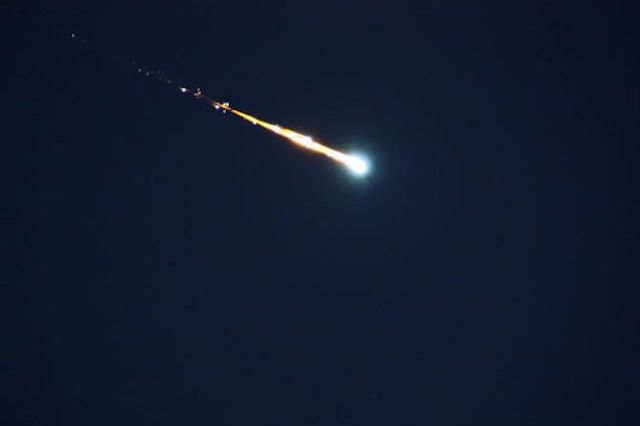The American Meteor Society so far has received 12 reports of the bright and large meteor seen over Connecticut, New Hampshire, Maine and New Brunswick just after midnight Tuesday. Jeff Beam of Falmouth was one of six Mainers who reported seeing the meteor.
BRIGHT fireball over southern Maine a few minutes ago. I was driving and noticed the sky brighten and flicker. I caught the tail end over my shoulder as it fragmented. That was one of the better ones I've seen.
— Chris Legro (@OceanStWx) December 12, 2018
"It was spectacular. It looked like a slow-motion roman candle or something," Beam wrote in an entry on the meteor society's website. "It felt like it was rather close above me, but it was probably pretty far away."
Other reports of the fireball came from Mainers in Alfred, Kittery, Limerick and Peru.
Meteorologist Chris Legro of the National Weather Service in Gray also spotted the meteor in Falmouth as he was driving home from work. He posted on Twitter that he saw "the sky brighten and flicker" and that it was "bright enough to light up the whole sky."
"I caught the tail end over my shoulder as it fragmented," Legro wrote. "That was one of the better ones I've seen."
A meteor is the streak of light emitted when a meteoroid enters the earth's atmosphere. The brightness of a meteor depends on the meteoroid's size, composition and angle of entry, Legro said.
"A fireball is just an usually large meteor," said Legro, who has seen about a half-dozen meteors in his life, largely because he regularly works some night shifts.
Meteors occur all the time, he said, but they can't be seen during the day, most people aren't awake to see them at night, and clouds and weather often get in the way. Even so, other fireballs have been spotted in Maine, including one in 2016 that was caught on the dashboard camera of a Portland police cruiser and generated so much traffic on the American Meteor Society website that it temporarily caused it to crash.
Once a meteor lands, it's known as a meteorite. Based on the reported trajectory of the fireball seen Tuesday night, it likely landed somewhere in the Gulf of Maine, Legro said, assuming it made it through Earth's atmosphere without burning up.
The best time to spot a meteor is between midnight and dawn, but the ongoing Geminid meteor shower is providing additional opportunities because of increased frequency.
"The Earth happens to be rotating through this debris field right now," Legro said.
The meteor shower is named for its constellation of origin, which is Gemini, and viewing is especially good now because Gemini is high in the night sky, rather than low on the horizon, Legro said. It also helps that the moon is less than a quarter full, so the sky is fairly dark.
The shower is expected to peak Thursday night. Clouds will be increasing in southern Maine in the coming days, so viewing may be spotty at times. Stargazers farther north will find their efforts largely unobscured.
The city of South Portland and Southern Maine Astronomers will host a free meteor shower event from 7 to 8:30 p.m. Thursday at the Wainwright Sports Complex, 125 Gary Maietta Way. The evening will begin with a tour of the night sky and winter constellations. Everyone will be provided with a sky map to take home. Participants are urged to bundle up and bring a reclining lawn chair. Hot beverages will be served.




Comment: Local news station, WOKQ 97.5, reported a loud boom that was heard across Maine: